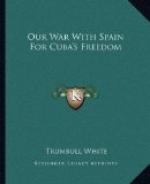We were up at 4 o’clock, had breakfast at 6, and then, on the morning of June 24th started from Siboney across a high hill leading to La Quasina, where the regiment had its first fight. The battle lasted two hours and forty minutes, though to those who took part in it it appeared a very much shorter time. As we were advancing we were constantly expecting a fire from the Spaniards. We were not ambushed at all.
After we had gone about two miles on that trail we came across the body of a Cuban, and after that we kept an especially sharp lookout. Troop L formed the advance guard, and we had skirmishers out ahead of us and to both the right and left. The skirmishers ahead of us were about 250 yards from the main body of our men, and it was one of these advanced skirmishers who discovered the Spaniards. Thomas E. Isbell, a Cherokee from Vinita, I. T., was the one to make the discovery of the Spanish force. He fired the first shot in that battle and dropped a Spaniard. Isbell was wounded seven times and then managed to walk back to the field hospital, two and a half or three miles away, to get his wounds dressed.
Hard fighting ahead.
As soon as we learned that the Spanish were in advance of us we deployed the men six feet apart, advancing into the firing line. The Spaniards had some machine guns ahead of us, and our men received the full force of this fire. There was also firing from the right and the left. We were at this time upon the knoll of a hill, the Spaniards being about us at lower elevations. Before Isbell discovered the Spaniards a blockhouse had been seen, and we knew what was ahead of us.
It was probably half or three-quarters of an hour after the firing began that Captain Capron was killed, and perhaps twenty minutes after that I was struck as we were about to make a charge. Our men had been instructed to save their ammunition and not shoot unless they saw something to shoot at. Our men and the Tenth infantry afterwards buried about 100 Spaniards, and great numbers of their killed and wounded among them were carried to the rear, so that the fire on our side must have been pretty accurate.
When asked to relate some of the scenes taking place about him before he was struck, he replied:
One of the worst things I saw was a man shot while loading his gun. The Spanish Mauser bullet struck the magazine of his carbine, and going through the magazine the bullet was split, a part of it going through his scalp and a part through his neck. This was Private Whitney, and from his neck down he was a mass of blood. He was taken back of the firing line, and had recovered before we left Siboney and was again back in the ranks.
Captain Capron showed great pluck on the field of battle, and refused to leave even when he was mortally wounded. We were at that moment deploying and lying down. He was struck in the left shoulder, the ball coming out of his abdomen. He lived one hour and fifteen minutes after being shot. He was taken back to the field hospital by some of our men. About twenty minutes after that a Mauser ball struck me in the leg.




